Shiyin Li
Comparative Performance Analysis of Different Hybrid NOMA Schemes
Sep 18, 2025Abstract:Hybrid non-orthogonal multiple access (H-NOMA), which combines the advantages of pure NOMA and conventional OMA organically, has emerged as a highly promising multiple access technology for future wireless networks. Recent studies have proposed various H-NOMA systems by employing different successive interference cancellation (SIC) methods for the NOMA transmission phase. However, existing analyses typically assume a fixed channel gain order between paired users, despite the fact that channel coefficients follow random distribution, leading to their magnitude relationships inherently stochastic and time varying. This paper analyzes the performance of three H-NOMA schemes under stochastic channel gain ordering: a) fixed order SIC (FSIC) aided H-NOMA scheme; b) hybrid SIC with non-power adaptation (HSIC-NPA) aided H-NOMA scheme; c) hybrid SIC with power adaptation (HSIC-PA) aided H-NOMA scheme. Theoretical analysis derives closed-form expressions for the probability that H-NOMA schemes underperform conventional OMA. Asymptotic results in the high signal-to-noise ratio (SNR) regime are also developed. Simulation results validate our analysis and demonstrate the performance of H-NOMA schemes across different SNR scenarios, providing a theoretical foundation for the deployment of H-NOMA in next-generation wireless systems.
Modeling and Performance Analysis for Semantic Communications Based on Empirical Results
Apr 29, 2025Abstract:Due to the black-box characteristics of deep learning based semantic encoders and decoders, finding a tractable method for the performance analysis of semantic communications is a challenging problem. In this paper, we propose an Alpha-Beta-Gamma (ABG) formula to model the relationship between the end-to-end measurement and SNR, which can be applied for both image reconstruction tasks and inference tasks. Specifically, for image reconstruction tasks, the proposed ABG formula can well fit the commonly used DL networks, such as SCUNet, and Vision Transformer, for semantic encoding with the multi scale-structural similarity index measure (MS-SSIM) measurement. Furthermore, we find that the upper bound of the MS-SSIM depends on the number of quantized output bits of semantic encoders, and we also propose a closed-form expression to fit the relationship between the MS-SSIM and quantized output bits. To the best of our knowledge, this is the first theoretical expression between end-to-end performance metrics and SNR for semantic communications. Based on the proposed ABG formula, we investigate an adaptive power control scheme for semantic communications over random fading channels, which can effectively guarantee quality of service (QoS) for semantic communications, and then design the optimal power allocation scheme to maximize the energy efficiency of the semantic communication system. Furthermore, by exploiting the bisection algorithm, we develop the power allocation scheme to maximize the minimum QoS of multiple users for OFDMA downlink semantic communication Extensive simulations verify the effectiveness and superiority of the proposed ABG formula and power allocation schemes.
Task-Oriented Semantic Communication with Importance-Aware Rate Control
Apr 29, 2025Abstract:Semantic communication is recognized for its high compression efficiency and robust resistance to noise. However, utilizing a fixed transmission rate in environments with dynamic signal-to-noise ratios (SNR) often results in inefficient use of communication resources. To address this challenge, this letter proposes an importance-aware rate control semantic communication (IRCSC) scheme, which dynamically adjusts transmission rates in response to both channel conditions and semantic importance. The scheme employs a contribution-based importance analyzer to rank semantic importance. Additionaly, a novel metric, the semantic transmission integrity index (STII), is proposed to quantify the amount of correctly transmitted information and to correlate it with inference performance. Simulations indicate that, with low computational complexity, IRCSC guarantees a controllable trade-off between performance and rate, delivering higher compression efficiency and improved task performance in high-SNR scenarios.
Semantic Feature Division Multiple Access for Multi-user Digital Interference Networks
Jul 11, 2024Abstract:With the ever-increasing user density and quality of service (QoS) demand,5G networks with limited spectrum resources are facing massive access challenges. To address these challenges, in this paper, we propose a novel discrete semantic feature division multiple access (SFDMA) paradigm for multi-user digital interference networks. Specifically, by utilizing deep learning technology, SFDMA extracts multi-user semantic information into discrete representations in distinguishable semantic subspaces, which enables multiple users to transmit simultaneously over the same time-frequency resources. Furthermore, based on a robust information bottleneck, we design a SFDMA based multi-user digital semantic interference network for inference tasks, which can achieve approximate orthogonal transmission. Moreover, we propose a SFDMA based multi-user digital semantic interference network for image reconstruction tasks, where the discrete outputs of the semantic encoders of the users are approximately orthogonal, which significantly reduces multi-user interference. Furthermore, we propose an Alpha-Beta-Gamma (ABG) formula for semantic communications, which is the first theoretical relationship between inference accuracy and transmission power. Then, we derive adaptive power control methods with closed-form expressions for inference tasks. Extensive simulations verify the effectiveness and superiority of the proposed SFDMA.
Joint Beamforming Design for RIS-enabled Integrated Positioning and Communication in Millimeter Wave Systems
May 20, 2023

Abstract:Integrated positioning and communication (IPAC) system and reconfigurable intelligent surface (RIS) are both considered to be key technologies for future wireless networks. Therefore, in this paper, we propose a RIS-enabled IPAC scheme with the millimeter wave system. First, we derive the explicit expressions of the time-of-arrival (ToA)-based Cram\'er-Rao bound (CRB) and positioning error bound (PEB) for the RIS-aided system as the positioning metrics. Then, we formulate the IPAC system by jointly optimizing active beamforming in the base station (BS) and passive beamforming in the RIS to minimize the transmit power, while satisfying the communication data rate and PEB constraints. Finally, we propose an efficient two-stage algorithm to solve the optimization problem based on a series of methods such as the exhaustive search and semidefinite relaxation (SDR). Simulation results show that by changing various critical system parameters, the proposed RIS-enabled IPAC system can cater to both reliable data rates and high-precision positioning in different transmission environments.
Robust Power Allocation for Integrated Visible Light Positioning and Communication Networks
May 17, 2023



Abstract:Integrated visible light positioning and communication (VLPC), capable of combining advantages of visible light communications (VLC) and visible light positioning (VLP), is a promising key technology for the future Internet of Things. In VLPC networks, positioning and communications are inherently coupled, which has not been sufficiently explored in the literature. We propose a robust power allocation scheme for integrated VLPC Networks by exploiting the intrinsic relationship between positioning and communications. Specifically, we derive explicit relationships between random positioning errors, following both a Gaussian distribution and an arbitrary distribution, and channel state information errors. Then, we minimize the Cramer-Rao lower bound (CRLB) of positioning errors, subject to the rate outage constraint and the power constraints, which is a chance-constrained optimization problem and generally computationally intractable. To circumvent the nonconvex challenge, we conservatively transform the chance constraints to deterministic forms by using the Bernstein-type inequality and the conditional value-at-risk for the Gaussian and arbitrary distributed positioning errors, respectively, and then approximate them as convex semidefinite programs. Finally, simulation results verify the robustness and effectiveness of our proposed integrated VLPC design schemes.
Features Disentangled Semantic Broadcast Communication Networks
Mar 03, 2023



Abstract:Single-user semantic communications have attracted extensive research recently, but multi-user semantic broadcast communication (BC) is still in its infancy. In this paper, we propose a practical robust features-disentangled multi-user semantic BC framework, where the transmitter includes a feature selection module and each user has a feature completion module. Instead of broadcasting all extracted features, the semantic encoder extracts the disentangled semantic features, and then only the users' intended semantic features are selected for broadcasting, which can further improve the transmission efficiency. Within this framework, we further investigate two information-theoretic metrics, including the ultimate compression rate under both the distortion and perception constraints, and the achievable rate region of the semantic BC. Furthermore, to realize the proposed semantic BC framework, we design a lightweight robust semantic BC network by exploiting a supervised autoencoder (AE), which can controllably disentangle sematic features. Moreover, we design the first hardware proof-of-concept prototype of the semantic BC network, where the proposed semantic BC network can be implemented in real time. Simulations and experiments demonstrate that the proposed robust semantic BC network can significantly improve transmission efficiency.
Task-oriented Explainable Semantic Communications
Feb 27, 2023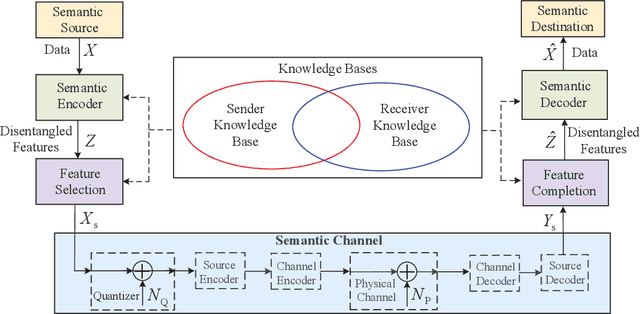
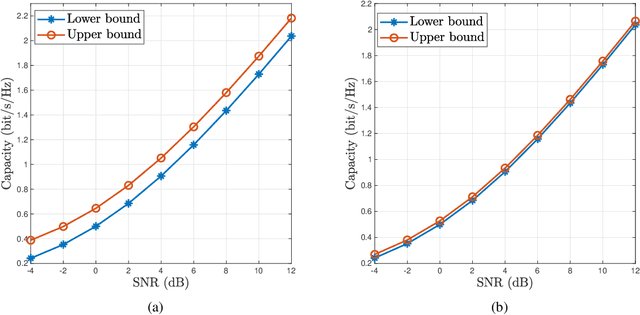

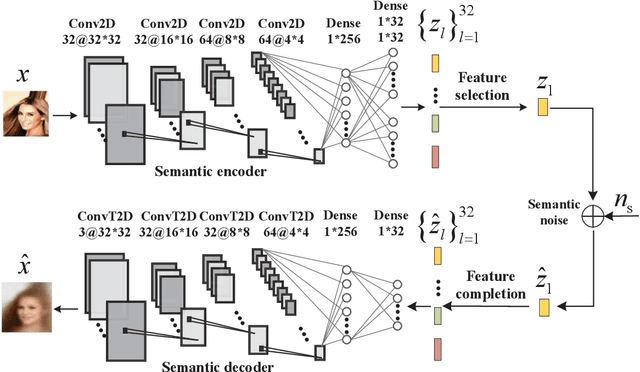
Abstract:Semantic communications utilize the transceiver computing resources to alleviate scarce transmission resources, such as bandwidth and energy. Although the conventional deep learning (DL) based designs may achieve certain transmission efficiency, the uninterpretability issue of extracted features is the major challenge in the development of semantic communications. In this paper, we propose an explainable and robust semantic communication framework by incorporating the well-established bit-level communication system, which not only extracts and disentangles features into independent and semantically interpretable features, but also only selects task-relevant features for transmission, instead of all extracted features. Based on this framework, we derive the optimal input for rate-distortion-perception theory, and derive both lower and upper bounds on the semantic channel capacity. Furthermore, based on the $\beta $-variational autoencoder ($\beta $-VAE), we propose a practical explainable semantic communication system design, which simultaneously achieves semantic features selection and is robust against semantic channel noise. We further design a real-time wireless mobile semantic communication proof-of-concept prototype. Our simulations and experiments demonstrate that our proposed explainable semantic communications system can significantly improve transmission efficiency, and also verify the effectiveness of our proposed robust semantic transmission scheme.
Joint Beamforming and PD Orientation Design for Mobile Visible Light Communications
Dec 21, 2022Abstract:In this paper, we propose joint beamforming and photo-detector (PD) orientation (BO) optimization schemes for mobile visible light communication (VLC) with the orientation adjustable receiver (OAR). Since VLC is sensitive to line-of-sight propagation, we first establish the OAR model and the human body blockage model for mobile VLC user equipment (UE). To guarantee the quality of service (QoS) of mobile VLC, we jointly optimize BO with minimal UE the power consumption for both fixed and random UE orientation cases. For the fixed UE orientation case, since the {transmit} beamforming and the PD orientation are mutually coupled, the joint BO optimization problem is nonconvex and intractable. To address this challenge, we propose an alternating optimization algorithm to obtain the transmit beamforming and the PD orientation. For the random UE orientation case, we further propose a robust alternating BO optimization algorithm to ensure the worst-case QoS requirement of the mobile UE. Finally, the performance of joint BO optimization design schemes are evaluated for mobile VLC through numerical experiments.
Optimal Power Allocation for Integrated Visible Light Positioning and Communication System with a Single LED-Lamp
Aug 30, 2022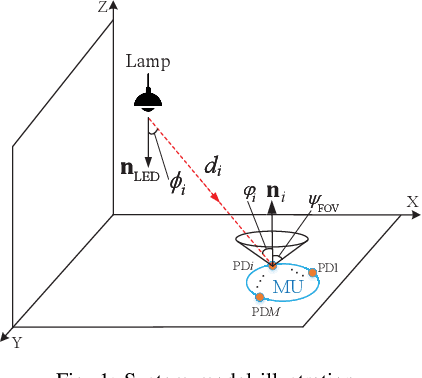

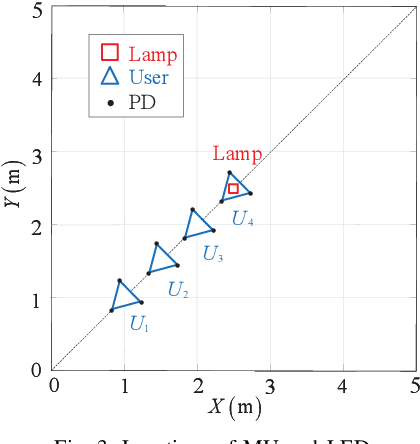
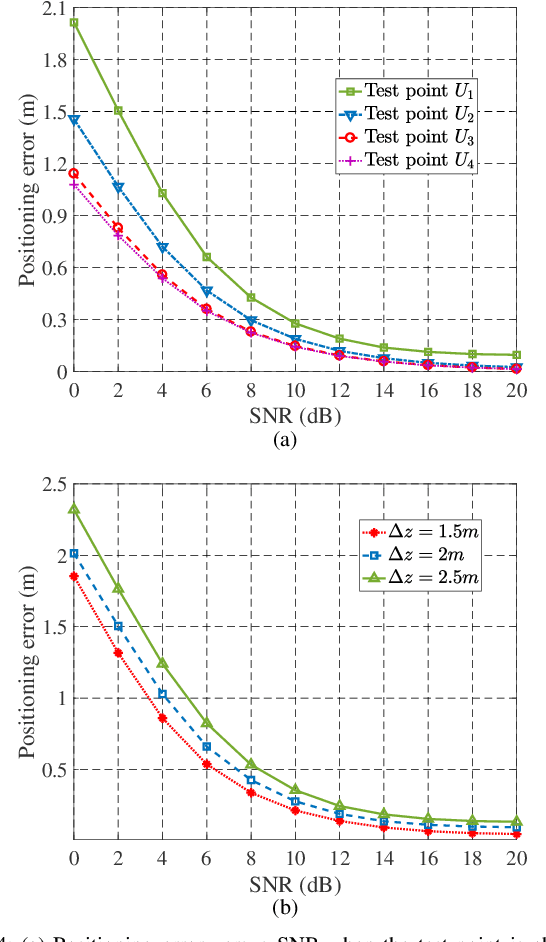
Abstract:In this paper, we investigate an integrated visible light positioning and communication (VLPC) system with a single LED-lamp. First, by leveraging the fact that the VLC channel model is a function of the receiver's location, we propose a system model that estimates the channel state information (CSI) based on the positioning information without transmitting pilot sequences. Second, we derive the Cramer-Rao lower bound (CRLB) on the positioning error variance and a lower bound on the achievable rate with on-off keying modulation. Third, based on the derived performance metrics, we optimize the power allocation to minimize the CRLB, while satisfying the rate outage probability constraint. To tackle this non-convex optimization problem, we apply the worst-case distribution of the Conditional Value-at-Risk (CVaR) and the block coordinate descent (BCD) methods to obtain the feasible solutions. Finally, the effects of critical system parameters, such as outage probability, rate threshold, total power threshold, are revealed by numerical results.
 Add to Chrome
Add to Chrome Add to Firefox
Add to Firefox Add to Edge
Add to Edge